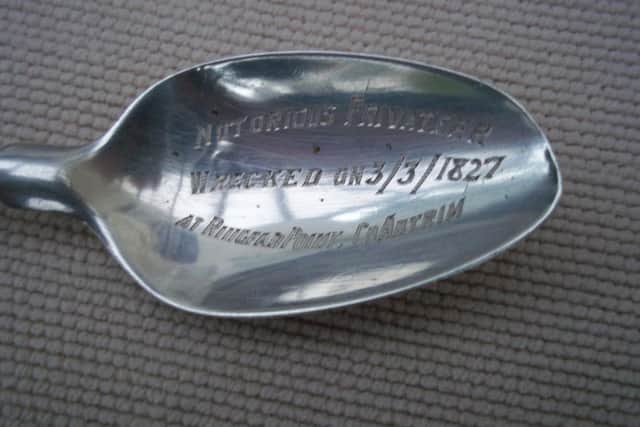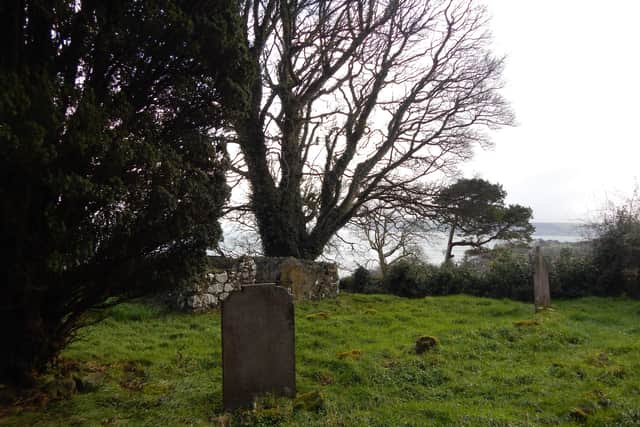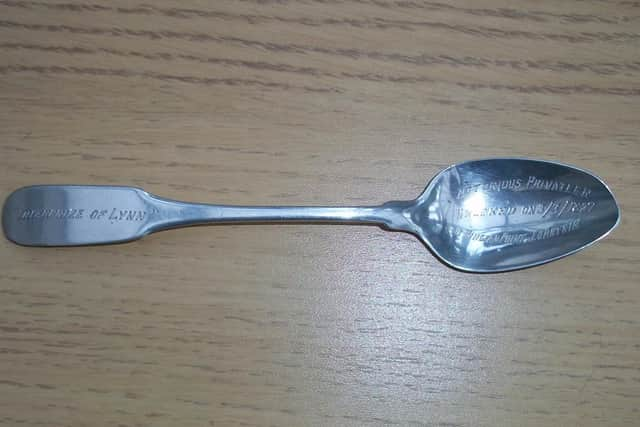Silver spoon is artefact from seafaring tragedy near Carnlough
and live on Freeview channel 276
Over the years Alan Millar, who used to have a shop in Carrickfergus, has built up a picture of events commemorated by the spoon, which came from a famous shipwreck north of Carnlough almost 200 years ago.
But mystery remains.
The spoon refers to the Enterprise of Lynn, which came to grief at Ringfad Point on March 3, 1827 in the midst of a snowstorm. The vessel was on her way home to Britain from Peru in South America, but never reached safe anchor. The story goes that the Enterprise had a cargo silks, fine woods, indigo, cotton and hides as well, it was later claimed, as gold and silver coins.


Advertisement
Hide AdAdvertisement
Hide AdThe captain was named John Bond and his wife and family members were also on board the ship. At the time construction to erect lighthouses was beginning at the Maidens and it was said that the workmen had a light there, which was seen from the ship. Those on board were unaware of the situation at the Maidens, and accordingly are believed to have concluded that the light was at the Copeland Islands, which did have a lighthouse, and this resulted in Captain Bond altering the course of the ship. The tragic result was that the Enterprise went onto the rocks at Ringfad Point north of Carnlough.
Most of those on board the ship perished in the waves and were buried in a common grave at the corner of Nappan cemetery nearby. The wreck of the Enterprise excited much comment afterwards because there was plunder of the bodies of the drowned by some of those who arrived at the scene, according to accounts. Their neighbours were disgusted by the activities and legend has it that often items such as rings and jewellery were hidden by those concerned as they were ashamed to show or wear them. One man was said to have made off with a sackful of doubloons, then worth about 21 shillings each, but the news spread about this and alerted the coastguards, who confiscated the find.
Among those who was on the scene of the disaster was William McGilliard of Nappan, and he was credited with rushing into the stormy waters to rescue several people who would otherwise have drowned. Another local man, Hugh McGreer of Straidkilly, Glenarm, wrote a song about the traumatic incident. It includes the verses;
“Twas on the third of March, brave boys, in the year of ’27,


Advertisement
Hide AdAdvertisement
Hide AdOur good ship through the dark and storm was by Glenarm driven
The hail and sleet together met, the spindrift it blew high,
Together with a fall of snow, and dreadful was the sky
The Enterprise of Lynn, brave boys, it was our good ship’s name,


She was laden with dollars and indigo, and from Peru she came,
She crossed the western ocean, where flaming billows roar,
And left her precious cargo, along the Largy shore.”
Advertisement
Hide AdAdvertisement
Hide AdThe poem attributes the captain’s wife for making the navigational mistake that the workman’s light on the Maidens was the Copeland Islands and details the wreck of the vessel, emphasising outrage at the plunder of the bodies, particularly of rings and jewellery. The song concludes;
“Come all ye friends and neighbours, the truth to you I’ll tell,
It was in Andy McGalliard’s that they were treated well,
The Captain and his company were rushed in by the tide,
And they were buried in Nappin land – the grave was deep and wide.”
Alan Millar detailed that the spoon was in among a bundle of items which he bought some years ago; “I used to have a shop and it was bought in with other stuff. It is inscribed that it is from the ship and it has no hallmark, but a maker’s mark which has led me to believe that it was an early silver spoon which was not machine made,” he said. “I didn’t know anything about the wreck of the Enterprise until I found the spoon and then I felt compelled to find out about it,”
Advertisement
Hide AdAdvertisement
Hide AdAlan and his wife Michelle have been to the site of the tragedy at Ringfad Point and to the cemetery at Nappan.
“The cemetery was a bit out of the way and we had to ask in Carnlough. There was no gravestone or marker so we just know that there is a common grave for those who lost their lives in some corner. It’s quite a small cemetery,” he said.
Alan has been collecting antique items from the 1970s, and says that the Enterprise spoon will always have a pride of place in his collection. However, mystery remains over whom the spoon belonged to and who had it engraved in the first place. The reference to the vessel as a ‘notorious privateer’ is also not how the Enterprise is normally described, so it is not clear when the spoon was engraved with that wording.
The blizzard of March 1827 was one of the most destructive which had been witnessed for some time and left several wrecks in its wake. The most legendary was the Enterprise. In more recent times attempts by divers to find any evidence have, however, proved fruitless.
--
Advertisement
Hide AdAdvertisement
Hide AdClick here to read: Adrian Dunbar showcases east Antrim’s coastline
--
Thank you for reading this article. We’re more reliant on your support than ever as the shift in consumer habits brought about by coronavirus impacts our advertisers. Please consider purchasing a copy of the paper. You can also support trusted, fact-checked journalism by taking out a digital subscription of the News Letter.